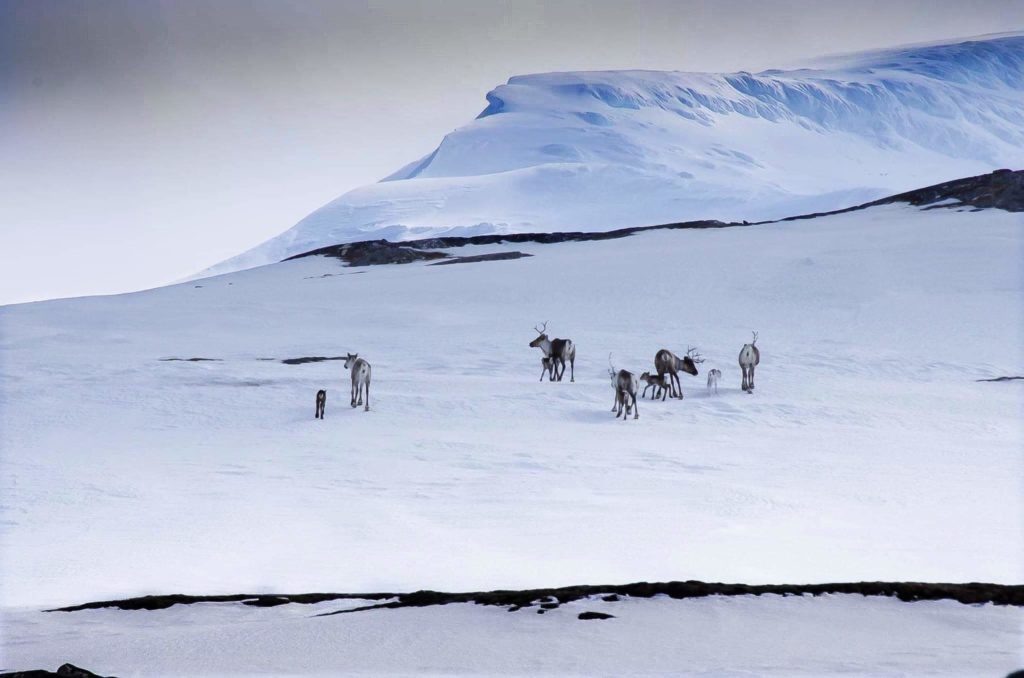
Watch the NRK documentary: The Battle against the wind power turbines
Written by Christina Fjeldavli, Motvind Norway. Translated from Norwegian by Per Svein Dufva. Film and photography by Ole Henrik Kappfjell, Tom Kvitnes and Merethe Kvandal.
According to the Norwegian Constitution § 108, the authorities “must see to that the Sámi society can safeguard and develop Sámi language, culture, and social life. ”The Law on Biodiversity § 1 says that “nature with its biological, topographical and geological diversity and ecological processes is to be taken care of through sustainable use and protection, also in a way that gives a foundation for people’s activities, culture, health and prosperity now and in the future, also as a foundation for Sámi culture”.
The development of wind power we see today could not have happened if the laws had been abided. Says Sverre Sivertsen: ”The development of today’s wind power has no match in the history of the Norwegian management of energy and nature.” Sverre Sivertsen is a former communications manager for The Norwegian Water Resources and Energy Directorate (NVE), the directorate that gives permission for wind power plants, thus he has a solid background for saying this. The way he sees it, Norwegian politicians have constructed a system making it possible for strong capitalistic forces to irreparably ruin the Norwegian nature without paying a penny for the loss. The development of windpower strikes the Sámi reindeer owners particularly hard.
Øyfjellet. Filmed by Ole Henrik Kappfjell.
Since the middle of the 1800s, the Norwegian authorities have tried to wind up Sámi culture by trying to turn the Sámi people into Norwegians (“Norwegianizing”). As a part of this Sámi children were sent to boarding schools where they were taught in Norwegian. The pupils were forbidden to speak their mother tongue. During the period 1968–1982, Norway constructed a large hydro-electric power dam and plant in Alta in Finnmark, and Sámi interests had to give way to the claims of the (Norwegian) majority. And now, since the turn of the century, Norwegian authorities have laid the ground for ruining one reindeer pasture after the other through a completely unnecessary development of wind power. Important pastures at Fosen have already been destroyed. Now the wind power industry has set its eyes upon Vefsn (Nordland county).

Jillen–Njaarke is an area for reindeer pastures with a spring herd of about 2200 reindeer, and Øyfjellet in Vefsn is a crucial area for the owners. To build a wind power plant here will be disastrous, and NVE and the Ministry for Oil and Energy (OED) have been thoroughly informed about this by several parties. ”The green light” from NVE (18.12.19) means that the pastures are forever lost, according to Runar Myrnes Balto, chairperson of Norske Samers Riksforbund (NSR) (The Norwegian Sámi Organisation). Balto is very critical to a Norwegian system that enables the realization of gigantic projects without paying attention to the reindeer business, which has been there for centuries. Balto also thinks that the project could have been stopped if the politicians had had the will to do so (NRK Nordland, 25.12.19).

Tone Toft and Bjørn Økern, representing Naturvernforbundet (NFF) Nordland, claim that Øyfjellet wind power plant has been a mistake from the very start and it needs to be “stopped immediately”. (There are several environmentalist organisations in Norway, NFF being the oldest. There is also one named Motvind (MN), the most recent, founded 2019 as an umbrella organisation for local groups fighting the windpower projects. And there is also Norges Miljøvernforbund (NMF). According to MN the windpower plant at Øyfjellet is planned in pristine nature, just of Lomsdal–Visten Nasjonalpark (National Park), also called “the hidden land”, one of the country’s most pristine landscapes. Here you will find 1102 square km of large plains, mountains, quiet fjords, and deep valleys where only the wind disturbs the primeval forest. A fourth environmentalist organisation La Naturen Leve (LNL) “says yes to a fossil-free future and yes to renewable energy. They think that we must leave nature as intact as possible for the future generations, and they proclaim a crystal clear NO to the wind power that ruins nature in a hydro-electric Norway. In other words, Norway has an excess of hydroelectric power. NMF reacted strongly when NVE gave permission to both Tysvær wind power plant (Rogaland county) and Øyfjellet the same day Sylvi Listhaug took over as minister of OED. NMF considers both Tysvær and Øyfjellet to be “very controversial projects with grave consequences”.

Zero, a self-appointed environmentalist organisation, that receives money from the wind power business, and as a rule is invited to debates in NRK TV when topics such as wind power are debated, has for years argued that wind power is wanted and needed. Norwea Vindkraftforening (the organisation of the developers) has also been a busy driving force. Representatives of the windpower trade eagerly claim that the construction of wind power plants in pristine nature is necessary for salvaging the planet’s climate, but there are clear signals that it is quite the contrary. UN concluded in 2019 that the loss of nature is one of the planet’s largest problems. Norsk Institutt for naturforskning (NINA) (…) states in a recently published report,”Karbonlagring I norske økosystemer”) (“Carbon storage in Norwegian ecological systems”)(NINA, 2020), that the best we can do for the climate is to take care of nature. (NINA is a public institute for research on nature).

NVE and OED have mostly ignored factual arguments from genuine environmentalist organisations. Unfortunately, only the organisations with strong economic interests have been permitted to give the premises for the central authorities. In spite of the country having a surplus of electric power and in spite of the fact that the wind power plants lose money, a loss that must be covered by the taxpayers, the authorities stick to the idea that it is legitimate to destroy unique mountain landscapes in order to build unnecessary windpower plants.
In the middle of the corona crises, the developers at Øyfjellet have ordered more than seventy turbines that will tower 180 m above the ground. Each turbine demands an area the size of half a football field. To transport and mount these turbines, one must build broad roads in what till now has been pristine nature. The solicitors for both parties discuss how this year’s migration of reindeer can take place between huge construction machines. Remedying measures have been offered by NVE, they may be useful this year; the grave fact is that in the long run, the reindeer farmers will be driven out of existence.
The Norwegian Prime Minister Erna Solberg also has a role as the leading force for UN’s sustainable future. On New Year’s Day 2020, she spoke to the nation and uttered the word “sustainable” eleven times. She could also proudly announce “that the new, large oilfield, Johan Sverdrup, works almost without the emission of greenhouse gases.” The plan is to electrify the Norwegian part of the continental shelf so that we can produce “emission-free” oil and gas. This is regrettably a well-established lie among the Norwegian public. The Government wants to send the hydroelectric power out of the country via cables, something that will stimulate further construction of wind power plants. The result is that we are going to lose more and more of the nature Sámi culture is so attached to.
The (displacement and) maltreatment of indigenous peoples is not unique to Norway. As a result, international treaties for the protection of these peoples have been agreed upon. The International Labour Organization (ILO) is UN’s organization for work. ILO’s convention nr 169, ratified by the Norwegian authorities in 1990, is a binding international law made to give the indigenous peoples specific protection. The convention has four articles signed by 23 countries. According to article 2, the government shall protect “the rights of the indigenous people(s) and…guarantee that their integrity is respected. Article 3 says that the government shall respect the indigenous people(s) relationship to the land area where they live or otherwise use”. Article 15 states that the “right to natural resources in their areas must be specially secured”. The construction of wind power plants violates all three articles.

Sámi settlements with reindeer as the main livelihood have existed for ages in Helgeland. This is a well-documented fact. A school for Sámi children was founded as early as 1772 in Mosjøen. In his book Reindrift og nomadisme på Helgeland (1986), Ørnulf Vorren says that in 1740 there were 102 families having reindeer as their main livelihood. 58 of these lived in Vefsn, the rest in Rana. All in all 400 families in Helgeland had reindeer as the main livelihood (Vorren vol 1, 12). There has been a conflict of interest between Norwegian settlers and Sámi nomadic people migrating with their reindeer ever since the former came to the district. The Sámi people have as a rule lost these struggles, but not always. In NOU (Norwegian Public Report) 2007 there is an interesting example of the opposite.
In NOU 2007 part 14 there is an account of a proprietor who dragged some Sámi people to court for trespassing his land, among other things, they had cut down some trees and repaired a small hut. The case ended in the Supreme Court and the Sámi people won. The verdict handled several issues, but the important here is the clear message that “in the relationship between the indigenous people and the Norwegian occupants, the latter must maintain and protect the former’s right to use the land as they have done for centuries”. In other words, in 1862 The Supreme Court rules that there is a precedent for using the pastures even if the Sámi people do not own the property. Today’s reindeer farmers, direct descendants of the Sámi people who went to Court in1862, experience that this precedent is no longer valid.

Maria Fjellheim of the University of Tromsø does research on the dilemma between politics on the climate and the rights of the indigenous peoples when it comes to the construction of wind power plants. Says Fjellheim: “wind power isn’t green, neither is it a shift. It’s just another industry fragmenting the Sámi culture bit by bit”. It is absurd to displace the Sámi way of living to achieve sustainability. Fjellheim’s research shows that “reindeer pasturing leaves an insignificant footprint, and it is greener and more sustainable than most other exploitations”. The President of the Sámi Parliament, Aili Keskitalo, uses the expression “green colonization” when she talks about the wind power industry. Research shows that this kind of colonization and the ruining of nature is the opposite of sustainable. In addition to that, wind power plants in reindeer areas are both unnecessary and illegal. Norwegian authorities are systematically violating national laws and international treaties, something that is a scandal of international interest. Since the Norwegian media have failed in passing on the seriousness of these matters, we should now turn to the international press and courts.
References
https://lovdata.no/dokument/NL/lov/1814-05-17-nn
https://lovdata.no/dokument/NL/lov/2009-06-19-100
Øyfjellet Wind AS må stanse anleggsarbeidet på Øyfjellet i Vefsn i perioden 10. april – 10. mai 2020
https://brage.nina.no/nina-xmlui/handle/11250/2650166
https://www.harvestmagazine.no/pan/aerede-lagmannsrett
https://www.nrk.no/sapmi/kaller-vindparkplaner-for-gronn-kolonisering-1.13701272
https://www.regjeringen.no/no/aktuelt/statsministerens-nyttarstale-2020/id2684109/
NOU 2007:14 Del 4: Samisk befolkning, bruk av natur og rettighetsforhold på Helgeland
Vorren, Ørnulf. Reindrift og nomadisme på Helgeland, bind 1 og 2 (1986)
Saken med Øyfjellet vindkraftverk viser alvorlig systemsvikt




12 Comments
Pingback: Happy Sami Day! Stop the wind industry on Sami land! - Bergensia
Pingback: WORLDMATCH
Pingback: โรงพิมพ์กล่องกระดาษแพคเกจจิ้ง
Pingback: เกมสล็อต
Pingback: k2 liquid spray amazon
Pingback: https://www.outlookindia.com/outlook-spotlight/the-14-best-press-release-distribution-services-of-for-enhanced-visibility-and-reach--news-301112
Pingback: Bauc
Pingback: site read
Pingback: aksara178 login
Pingback: แทงบอลออนไลน์ ขั้นต่ำ 10 บาท
Pingback: Fernald Belcampo scandal
Pingback: Project Mancave